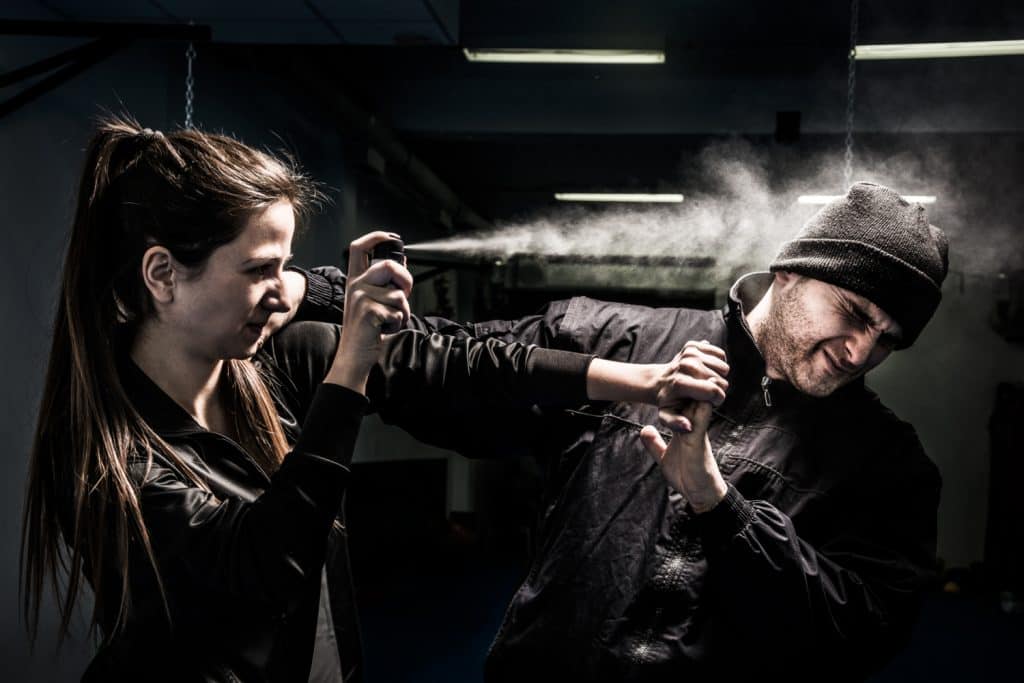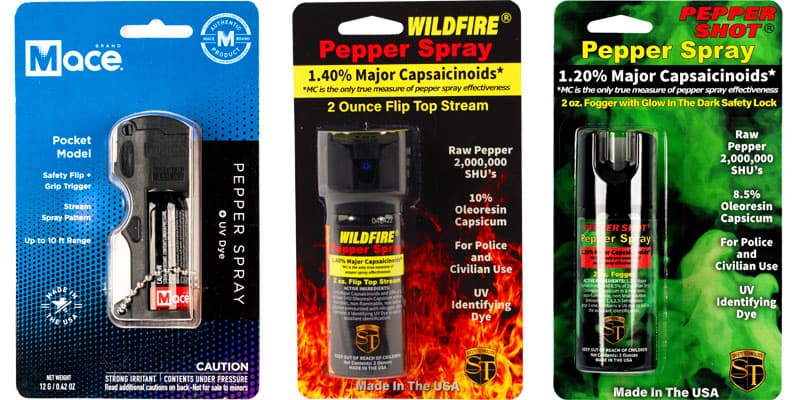PEPPER SPRAY
The purpose of the blog is to give you all the information you will need to make an informed decision about pepper spray and the best model to purchase.

In today’s uncertain world, personal safety is a top priority. One effective and convenient self-defense tool that has gained popularity is pepper spray. But what exactly is pepper spray, and how can it protect you? In this blog post, we will delve into the world of pepper spray, exploring its composition, benefits, popular brands, legal considerations, and proper use to help you make an informed decision about this powerful self-defense tool.
Short Summary
- Pepper spray is a powerful self-defense tool composed of capsaicin, ideal for incapacitating assailants.
- Popular brands such as Wildfire, Pepper Shot, and Mace offer varying ranges up to 15 feet with OC concentration and Scoville heat unit ratings.
- It is important to consult local law enforcement agencies regarding legal considerations before carrying pepper spray, and you should undertake training for proper use & maintenance.
Understanding Pepper Spray
Pepper spray is a self-defense tool composed of chili pepper extract, which is easy to carry and conceal in a pocket or purse. The active constituent of pepper spray is capsaicin, used by many police departments as a non-lethal self-defense tool. The immediate effects of pepper spray on a person may include:
- Involuntary closure of the eyes
- Restriction of the airways
- Acute pain around the face, nose, and throat
- Difficulty in breathing
Capsaicin is the active component in pepper spray, a popular self-defense device that elicits intense pain and inflammation when deployed against an assailant.
You can use pepper spray for personal safety in various situations, including:
- Traveling
- Home security
- Workplace security
- Walking alone
- Deterrent against animals
It comes in various sizes, making buying pepper spray for personal use easy. Some pepper spray canisters even have a quick-release key ring for easy access.
Maximum Strength Pepper Spray
Maximum-strength pepper spray contains:
- A higher concentration of capsaicin.
- Typically 10% to 18%.
- Making it more effective in stopping threats.
Brands like Wildfire, Pepper Shot, and Mace offer maximum-strength pepper spray, providing users with full self-defense capabilities and various sizes and attachment options for convenience.
It is essential to consult with local law enforcement agencies to know the legal considerations for carrying maximum-strength pepper spray, as some states may classify it as a weapon and impose specific regulations.
OC Spray vs. Tear Gas
OC spray, composed of oleoresin capsicum extracted from chili peppers, is a more potent and natural irritant compared to tear gas, which is usually formulated with chemicals such as CS (2-chlorobenzalmalononitrile) or CN (chloroacetophenone). While OC spray primarily affects the eyes, causing intense burning, pain, and temporary blindness, it also impacts the respiratory system, resulting in coughing and difficulty breathing.
In contrast, tear gas affects the eyes, nose, and throat, causing irritation, coughing, and choking. The effects of OC spray generally persist for 30 minutes to an hour, whereas the effects of tear gas can remain for several hours.
It is essential to be aware that OC spray and tear gas should be employed responsibly and adhere to local laws and regulations.
How Pepper Spray Provides Personal Safety
Pepper spray offers personal safety by incapacitating attackers, preventing accidental discharge, and including UV marking dye for identification. The effects of pepper spray vary based on factors such as the sprayed quantity, exposure time, and individual tolerance. Generally, they can last up to 45 minutes. Pepper sprays usually do not lead to any lasting damage to the target.
Moreover, products like the Pepper Shot Pepper Spray and Key Ring provide:
- A twist lock safety to avoid unintentional discharge
- A quick release with a detachable key chain for enhanced portability.
Accidental Discharge Prevention
Safety features on pepper spray canisters help prevent accidental discharge, ensuring user safety. Measures to avert accidental discharge include:
- Keeping the finger outside the trigger guard until prepared to shoot
- Verifying the holster is free of obstructions
- Opting for quality equipment
- Performing appropriate weapon maintenance and storage
- Refraining from making modifications to the gun
Utilizing quality equipment and performing proper maintenance helps ensure the weapon functions optimally and minimizes the chance of accidental discharge. Awaiting backup before contacting a subject is essential to guarantee the user’s safety and reduce the possibility of accidental discharge.
UV Marking Dye
UV marking dye in some pepper sprays assists in identifying attackers after an incident. This dye is not visible to the unaided eye but is detectable under ultraviolet light, assisting law enforcement in identifying and apprehending the perpetrator. When you deploy pepper spray, the UV marking dye releases a fluorescent dye that is not visible to the unaided eye but is detected under ultraviolet light.
The primary advantage of UV marking dye is that it assists law enforcement in identifying and apprehending the perpetrator. It’s also a deterrent, as assailants may be less likely to commit the act if they know they can be identified.
However, the primary disadvantage of utilizing UV marking dye is that it can be challenging to detect in certain lighting conditions, and the dye can be removed with water, so it may only be suitable in some scenarios.
Popular Pepper Spray Brands
Popular pepper spray brands include:
- Wildfire: an effective, non-lethal self-defense tool that contains a powerful blend of Oleoresin Capsicum (OC) and other natural ingredients, designed for ease of use and with a range of up to 10 feet.
- Pepper Shot: a trusted brand offering various pepper spray options for personal protection.
- Mace: a well-known brand that provides a range of pepper spray products with different features and strengths.
Wildfire Pepper Spray
WildFire Pepper Spray stands out in the market with 1.4% Major Capsaicinoids as one of the hottest. Beyond causing attacker pain, its 10% Oleoresin Capsicum Formula also causes mucous membrane swelling, making breathing difficult, and eye vein engorgement, which forces eyes to shut.
Made of 2 million SHU’s of raw pepper, its effects last up to 45 minutes before wearing off, with no lasting damage or permanent injury. Features a UV dye that can assist with the identification of an attacker.
Pepper Shot Pepper Spray
Pepper Shot Pepper Spray contains 1.2% Major Capsaicinoids – the accurate measure of heat – making it more effective than most pepper sprays. In addition to causing pain for an attacker, this 8.5% Oleoresin Capsicum formula also swells mucous membranes making breathing difficult, constricting veins in the eyes, causing eyes to close temporarily, causing no permanent damage and lasting up to 45 minutes with no permanent side effects. A UV dye helps identify attackers.
Pepper Shot Pepper Spray is offered in various sizes, from 1/2 ounce to 4 ounces, making it suitable for different needs and preferences.
Mace Pepper Spray
Mace Pepper Spray is a well-known brand with various products for different situations. Mace is renowned for its diverse selection of products to suit various scenarios, offering adequate protection and peace of mind.
Mace Pepper Spray is formulated with Oleoresin capsicum (OC), a naturally occurring substance, and is widely recognized for its precision and efficacy in delivering its maximum strength formula. Its reputation for reliability and effectiveness makes it a popular choice for those seeking personal protection.
Legal Considerations for Carrying Pepper Spray
Legal considerations for carrying pepper spray vary by location, with some states imposing restrictions on size and strength. In some areas, pepper spray may be considered a weapon and thus subject to specific regulations. It is essential to consult with local law enforcement agencies to know the legal considerations for carrying pepper spray in your area.
You can carry pepper spray in the United States if you are 18 or older. Still, reviewing the relevant state and local regulations is crucial, as restrictions may vary by state and region.
In Canada, the law classifies pepper spray as a prohibited weapon. Law enforcement officers are the only people authorized to carry or possess pepper spray labeled for use on persons in Canada. Possession and use of said pepper spray is not allowed to anyone else.
Proper Use and Maintenance
Proper use and maintenance of pepper spray involve:
- Training, practice, and understanding of the product’s features and limitations
- Holding it in a fist and deploying it with the thumb rather than the index finger
- Directing it at the assailant’s face from a close range in a stream, spray, or mist
- Maintaining a safe distance from the assailant
- Being aware of your surroundings
It would be best to routinely replace your pepper spray, regardless of whether you have used it. Pepper spray is usually good for 3-4 years. Proper maintenance ensures the product remains effective and safe to use in a self-defense situation.
Training and Practice
Training and practice with pepper spray are essential for practical self-defense and confidence in using the product. Various training options include online courses, in-person classes, and instructional videos. Practicing with pepper spray helps to develop muscle memory and ensures the user can use the product quickly and accurately in various scenarios.
It is crucial to take safety precautions when utilizing pepper spray, such as avoiding contact with the eyes, using the product in a well-ventilated area, and storing the product in a secure location. With proper training and practice, you can maximize the effectiveness of your pepper spray and feel more confident in your ability to protect yourself.
Summary
In conclusion, pepper spray is a powerful self-defense tool, offering personal safety through its potent active ingredients, various delivery options, and unique features like UV marking dye and accidental discharge prevention. Understanding the legal considerations for carrying pepper spray and learning proper use and maintenance through training and practice are essential for maximizing its effectiveness. By familiarizing yourself with popular brands like Wildfire, Pepper Shot, and Mace, you can choose the best pepper spray option for your needs, ensuring your safety and peace of mind.
Frequently Asked Questions
What states is it illegal to carry pepper spray?
Pepper spray is generally legal to carry in all 50 states. However, various restrictions regarding size, formulation, and possession may vary by state or locality.
These restrictions can include the container’s size, the formulation type, and the circumstances under which you can legally possess it. For example, some states may allow pepper spray to be carried for self-defense, while others may restrict its use.
Which is better, Mace or pepper spray?
Mace is a brand name that manufactures pepper spray and tear gas products. Both products contain oleoresin capsicum (OC), a naturally occurring substance from hot peppers.
What is the active ingredient in pepper spray?
The active ingredient in pepper spray is capsaicin, extracted from chili peppers, which causes intense pain and inflammation.
What is the difference between OC spray and tear gas?
OC spray and tear gas differ in formulations, with OC spray being made from oleoresin capsicum and tear gas formulated with chemicals such as CS or CN.
OC spray primarily affects the eyes and respiratory system, while tear gas impacts the eyes, nose, and throat.
What are the different types of pepper spray?
Pepper spray comes in various forms, each with distinct characteristics for specific scenarios. The three primary types include stream, fog, and foam/gel. Stream sprays provide a narrow burst that can reach longer distances, making it an excellent choice for outdoor use. Fog sprays disperse a cloud of pepper spray, useful in situations where accuracy might be difficult. Foam and gel sprays stick to the attacker’s face and are harder to wipe off, offering an advantage in close-quarters confrontations. Each type has its benefits and drawbacks, and the choice depends mainly on the individual’s needs, comfort, and the anticipated situation.
What are the pros and cons of using pepper spray?
Pepper spray, like any self-defense tool, comes with both advantages and disadvantages. On the pro side, it’s compact, easy to use, and can effectively incapacitate an assailant from a safe distance, giving the user time to escape and seek help. Its non-lethal nature also makes it preferable for those uncomfortable with more deadly force. However, the cons include the potential for misuse or accidental discharge, causing injury to the user or innocent bystanders. Additionally, it may require precision and composure to aim effectively in high-stress situations. Finally, it’s worth noting that pepper spray is not guaranteed to stop all attackers, particularly those under the influence of certain substances or with high pain tolerance.
How does pepper spray affect the body?
The body experiences an immediate and intense reaction when exposed to pepper spray. The active ingredient, capsaicin, triggers a burning sensation on any skin and mucous membranes it comes into contact with. This typically causes the eyes to close due to severe irritation involuntarily. Furthermore, capsaicin induces a coughing fit as it irritates the respiratory tract, making breathing difficult but not impossible. In some cases, nausea and disorientation may also occur. These effects are temporary, typically subsiding entirely within a few hours, but can be pretty debilitating at the moment, making pepper spray an effective tool for personal defense.
How effective is pepper spray in deterring an attacker?
Pepper spray has proven to be a highly effective deterrent in many instances of potential danger. Its immediate and incapacitating effects often provide crucial moments for potential victims to escape from an assailant. However, its effectiveness can vary based on certain factors such as distance, wind conditions, and the attacker’s determination. The spray’s impact depends on the user’s ability to aim accurately under stress. Despite these variables, pepper spray remains a popular and valuable tool for personal protection due to its non-lethal nature, ease of use, and the significant physical discomfort it can induce in an attacker.
What precautions should I take when carrying pepper spray?
When carrying pepper spray, it’s essential to handle it responsibly to prevent accidental discharge or misuse. Keep the spray in an easily accessible location but out of the reach of children or those who may misuse it. Regularly check the expiration date, as expired spray may not work effectively when needed. Familiarize yourself with how to use it properly, including the safety mechanism and spray range, and consider practicing with a training unit. Avoid carrying it in extreme temperatures, as excessive heat can cause the canister to leak or burst. Lastly, remember that having pepper spray is a serious responsibility and should only be used as a last resort for self-defense.
How do I safely store pepper spray?
Pepper spray should be stored in a safe, secure location where it is easily accessible in case of emergencies but out of reach from children or those who might misuse it. The storage area should be cool and dry, as extreme temperatures can affect the effectiveness of the spray or potentially cause the canister to leak or burst. Regularly inspect the condition of the canister for any signs of damage or leaks. If the pepper spray expires, be sure to replace the canister once it has reached this date to ensure its effectiveness. Lastly, always carefully handle the pepper spray and never point the nozzle toward your face when inspecting the canister.
Is pepper spray dangerous to use indoors?
Using pepper spray indoors carries certain risks and should be done with caution. The confined space can increase the risk of exposure to the user and other innocent individuals. Additionally, the lingering effects of the spray can contaminate the indoor environment for an extended period, leading to discomfort long after the initial use. Ventilation can be challenging, heightening the risk of prolonged exposure. Hence, while it can still serve as an effective self-defense tool indoors, it should only be used when necessary, and other safety measures should be considered.
What safety features should I look for when buying pepper spray?
Several safety features must be considered when purchasing pepper spray to ensure you choose the most effective and reliable option. One critical feature is a safety cap or locking mechanism to prevent accidental discharge. Look for products with a high Scoville heat unit (SHU) rating and a high percentage of oleoresin capsicum (OC), the active ingredient that causes the burning sensation. Markings or UV dye can be beneficial for helping law enforcement identify an attacker later. The range of the spray is also essential; a more extended range allows you to keep a safe distance from a potential threat. Lastly, consider a product with a quick-release keychain for easy emergency access.
How do I use pepper spray correctly?
To use pepper spray correctly, proper preparation and understanding are key. First, remove the safety mechanism (if one exists) to allow for rapid deployment. Aim for the assailant’s face, specifically the eyes, as this is the most sensitive area. Hold the canister with your dominant hand and extend your arm fully to create as much distance as possible between you and the attacker. Use your thumb to press down on the bottom of the spray, rather than your index finger, for a stronger and more stable grip. Once you’ve deployed the spray, don’t hang around. Use this opportunity to escape and seek help immediately, leaving the disoriented attacker behind.




